

Description
Based on our proprietary polymer synthesis technology, PolyJet DNA In Vitro
Transfection Reagent is formulated as a biodegradable polymer based DNA transfection reagent that
ensures effective and reproducible transfection on HEK293,
COS-7,
NIH-3T3, HeLa, CHO and a broad ranges of hard-to-transfect mammalian cells. PolyJet reagent is able to
immobilize DNA migration during electrophoresis at very low concentration and
form transfection complex within 5 minutes at RT. A remarkable feature of the
reagent is the rapid and complete degradation of polymer after transfection
complex endocytosis (Figure 1), leading to much less cytotoxicity. PolyJet
reagent, 1.0 ml, is sufficient for ~667 transfections in 24 well plates or ~333
transfections in 6 well plates, providing a very affordable alternative to the
leading products for transfecting a variety of commonly used and
hard-to-transfect mammalian cells.
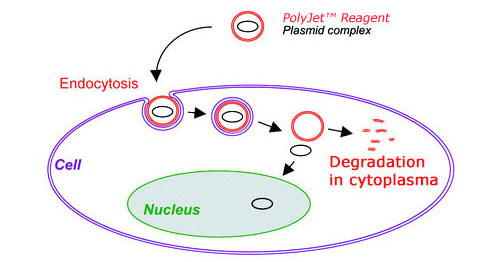
Figure
1. A Cartoon Showing Biodegradation of PolyJet
DNA Transfection Reagent After Endocytosis of Transfection Complex
Features
- Bio-degradable
after endocytosis
- Exceptional high titers of virus production
- Equally good for very long DNAs (>89 kb)
- Equally good for both single DNA transfection and multi DNA
co-transfection
- High levels of recombinant protein production
- Simple & robust transfection procedure
- Very affordable
Storage
Condition
Store at 4 °C. If stored properly, the product is stable
for 12 months or longer.
|
Cell Lines |
Efficiency (% GFP) |
Cell Lines |
Efficiency (% GFP) |
| McArdle 7777 Hep3D SHEP 3T3-442A COS-7 CV-1 D 407 DHD Pro.b 3LL B16-F10 BAEC BHK-21 Ca Ski CaCo2 CHO HCS-2/8 HEK-293 HeLa HLMEC H-MVEC Huh-7D12 ATT20 SK-N-SH C2C12 HepG2 |
65-70% |
hESCs |
70% |
Examples Showing Transfection Efficiency of PolyJet DNA In Vitro Transfection
Reagent on Commonly Used Cells
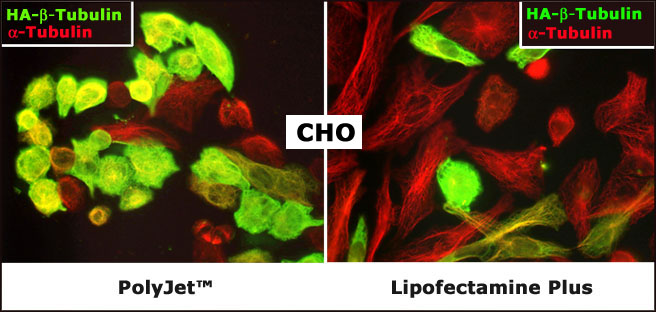
Transfection
efficiency comparison of PolyJet vs. lipofectamine Plus on Chinese Hamster
Ovary (CHO) cells. HA tagged beta-tubulin cDNA was delivered into CHO cells
with PolyJet (left panel) and lipofectamine Plus (right panel) respectively.
FITC conjugated antibody against HA tag was utilized to pick up HA-beta-tubulin
(Green) while a DM1a antibody was used to detect endogenous alpha-tubulin
followed by probing with rhodamine conjugated secondary antibody (Red). The
above picture was provided by Dr. Shang Yin of University of Texas at Houston
Medical School as courtesy
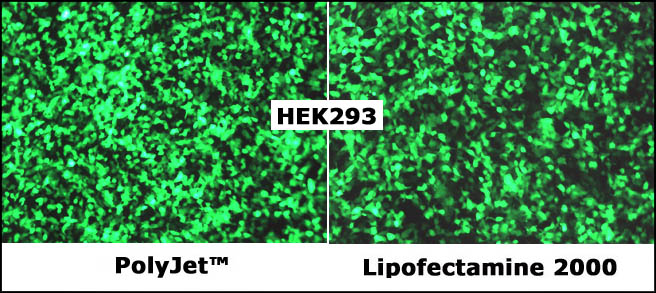
A comparison showing
transfection efficiency of PolyJet reagent vs. a leading product, Lipofectamine
2000 on HEK293FT cells. HEK-293FT cells were transfected with GFP vector
(pEGFP-N3) by PolyJet (left panel) and Lipofectamine 2000 (right panel)
respectively. The cells were visualized by Nikon Eclipse Fluorescence microscope
24 hours post transfection
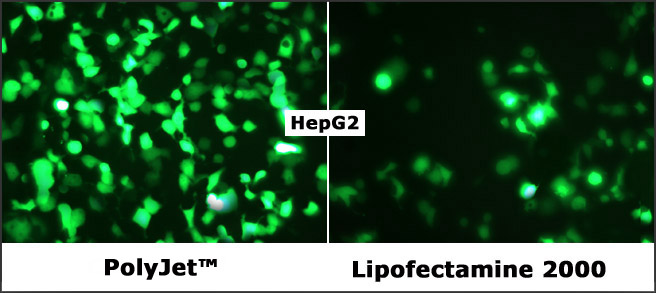
A comparison showing
transfection efficiency of PolyJet reagent vs. a leading product, Lipofectamine
2000 on HepG2 cells. HepG2 cells were transfected with GFP vector (pEGFP-N3)
by PolyJet (left panel) and Lipofectamine 2000 (right panel) respectively. The
cells were visualized by Nikon Eclipse Fluorescence microscope 24 hours post
transfection
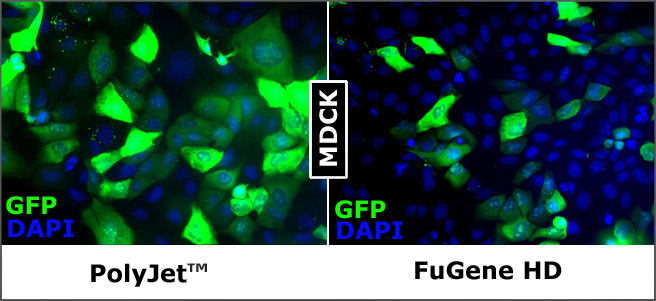
Transfection
efficiency comparison of PolyJet vs. Fugene HD on MDCK cells. A
plain GFP DNA was transduced into MDCK cells with PolyJet (left panel) and Fugene
HD (right panel) reagents respectively per manufacturers' protocols.
GFP and DAPI staining were visualized under fluorescence microscopy 48
hours post tansfection. The above comparison data and pictures were
completed and provided by Dr. Ge Zhou of NYU Medical Center as courtesy
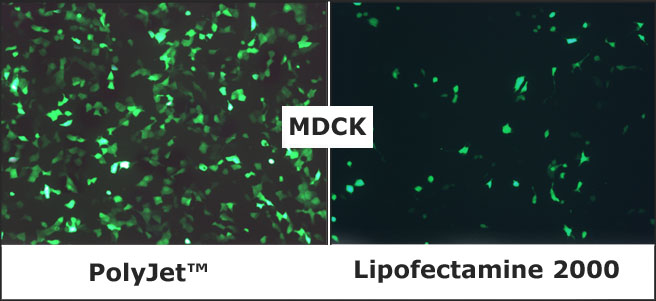
A comparison showing
transfection efficiency of PolyJet reagent vs. a leading product, Lipofectamine
2000 on MDCK cells. MDCK cells are notoriously hard to transfect. With
proprietary "Shaved Cell Transfection" protocol, PolyJet (left panel) gives up
to 70% GFP positive cells vs. Lipofectamine 2000 (right panel) around 5%
efficiency. MDCK cells were transfected with GFP vector (pEGFP-N3) by PolyJet
(left panel) and Lipofectamine 2000 (right panel) respectively. The cells were
visualized by Nikon Eclipse Fluorescence microscope 36 hours post transfection
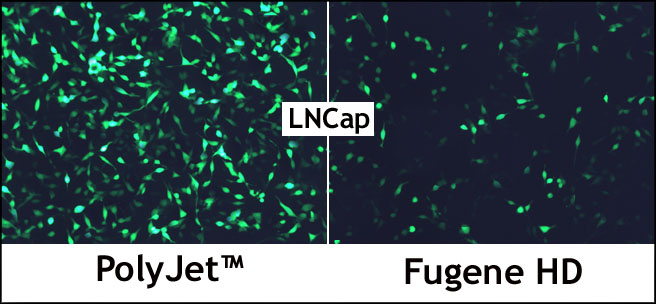
A comparison showing
transfection efficiency of PolyJet reagent vs. a leading product, Fugene HD on
LNCap cells. LNCap cells were transfected with GFP vector (pEGFP-N3) by
PolyJet (left panel) and Fugene HD (right panel) respectively. The cells were
visualized by Nikon Eclipse Fluorescence microscope 24 hours post transfection
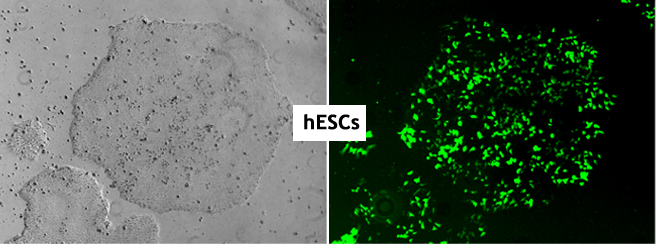
A image showing exceptional
transfection efficiency of PolyJet reagent
on Human embryonic stem cells (hESCs).
The
hESCs grown in E8 medium on Geltrexvs
(left panel, DIC imaging) was transfected with pEF1α-GFP.
The GFP expression (right
panel) was visualized by Nikon Eclipse Fluorescence microscope 24 hours post
transfection.
The above pictures were provided by Dr.
Marina Pryzhkova of
Johns Hopkins University as courtesy

Neuro2A cells transfected
with pEGFP-C1 plasmid using PolyJet In Vitro DNA
Transfection Reagent. The Neuro2A cells were visualized by Nikon
Eclipse Fluorescence microscope with DIC phase imaging (left) and FITC
imaging (right) 24 hours post-transfection
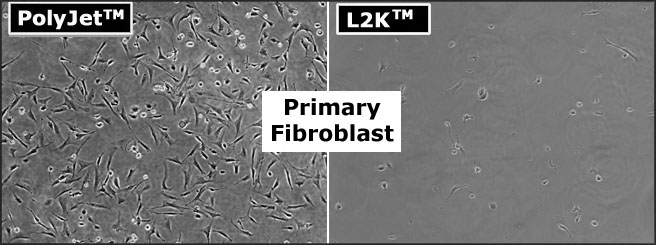
Comparison
of cytotoxicity of PolyJet DNA In Vitro Transfection
Reagent with L2K on primary murine skin fibroblast. The primary murine
fibroblast was incubated with the indicated transfection
reagents/pEGFP-C1 (DNA) complexes above for 4 hours in serum-free DMEM
High Glucose medium followed by replacement of complete
serum-containing medium. The cells were visualized by Nikon Eclipse
Fluorescence microscope with DIC phase imaging 24 hours post
transfection
Data Sheet and Protocols
-
General Protocol for Transfecting Mammalian Cells
![]()
-
A Short Protocol for Transfecting Mammalian Cells
![]()
-
Advanced Protocol for Transfecting
Hard-to-Transfect Mammalian Cells
![]()
-
A Protocol for Transfecting Suspension 293 and CHO
Cells
![]()
-
Protocol for Lentivirus Production
![]()
-
Protocol for rAAV Production
![]()
- Technical Note & Transfection Tips
![]()
Great News! We are offering "Wireless PowerPoint Presenter"
to customers who purchase 5x1.0 ml PloyJet or
more by March 2010. Take advantage of it and don't let this chance go...
|
|
|
FG-3: Wireless PowerPoint Presenter with Case for purchase of 5 X 1.0 ml or more. This presenter is offered for limited time only! |
To request a free trial sample, please
Create An Account with us to enter
your shipping address and email us at
order@signagen.com
![]()
Testimonials:
Sorry
for sooo big delay, but now I am totally in love with PolyJet. I have used
PolyJet for a while on mouse ESCs with relatively good efficiency 50~70%.
--------Marina Pryzhkova, Ph.D., JHU
PolyJet Transfection Reagent worked equally as well as lipofectamine
2000, with little evidence of cell death on 293, PC-3 and 22RV1 cells.
I will defiantly consider switching over.
-----Tiffany Wallace, Ph.D., NCI / NIH
I
only did side by side with the testing sample (PolyJet) and Lipo2000
with GFP transfection on COS-7 cells. The result was very good. PolyJet
was even better than L2K.
------Feng Qiao, Ph.D., NEI / NIH
I tested the sample of PolyJet on my NIH-3T3 mouse fibroblasts this
weekend. The results were much better than Lipofecatmine LTX. I'm
attaching a powerpoint slide with my results (I did not quantify the %
transfection efficiency, but the pictures get the point across). I
found that the protocol for difficult-to-transfect cell lines worked
better than the standard protocol.
-----Stephanie Murphy, Ph.D., Dartmouth College
I had chance to try your product finally. It was great success. I used HeLa
cells and got 10% transfection efficiency (<0.1% for Lipofectamine). Thank you!
I was wondering if I also try GenJet Plus DNA In Vitro Transfection Reagent?
According to your website, the reagent works better than regular PolyJet.
-------Yumi Uetake, Ph.D., UMASS
I tested PolyJet and it looks great on MDCK. We placed order. Thank you!
-------Ge Zhou, Ph.D., NYU
We
are happy to provide feedback. PolyJet worked very well for us in HepG2
cells, we got approximately 80% efficiency with pMAX GFP plasmid, by
following the conditions in your suggested protocol. We ran a
comparison with Lipofectamine, which only showed approximately 20-30%
transfection efficiency. We are planning experiments and will be
ordering more soon.
-------Emily Mcallister, PBRC
SignaGen公司是一家专注于开发和生产基因转导工具的企业,服务于生物医学研究领域。借助我们独有的技术平台(美国专利商标局号码为 072308和61135606),SignaGen已经成功开发出三大类 DNA/siRNA转染试剂,经验证我们的产品比市场上主导产品效率更高,细胞毒性更低。更重要的是我们提供一个合理的价位。












